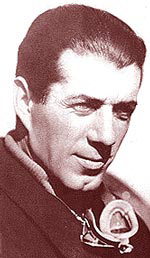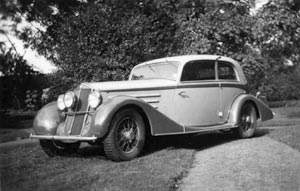By Estanislao Iacona & Cristi�n Bertschi
Photos courtesy of the Carlo Pintacuda Collection


A photo of Carlo Pintacuda during his years with Scuderia Ferrari. He would become a master of the
Mille Miglia and one of Alfa Romeo's finest sports car drivers of the 1930s.
|
Becoming a race driver
Carlo Pintacuda held a steering wheel for the first time at the age of 13. The car was a 30 hp Darraq, owned by his father. In 1914 his family bought a Nazzaro which had just won the Giro di Sicilia driven by its builder, Felice Nazzaro. Later, Carlo had the opportunity to drive a more powerful car with a better handling, an Aquila Italiana, a six-cylinder car built in Turin by Ing. Marsaglia. The young Pintacuda also drove a Lancia Kappa, and then an Isotta Fraschini.
During WWI Carlo became a volunteer in the Italian army, and when the war was over, he immediately returned to his passion of racing. His first race was in 1925 at the wheel of a Lancia Lambda Sport, in a race held at Livorno. Although he was first from the start, his youth betrayed him. He reached a turn too fast and crashed heavily. Fortunately, he was not badly hurt, and the Lancia returned home, pulled by two horses.
In 1926 he bought a 6-cylinder, 3-liter Alfa Romeo RLSS in which he won his first victory in a sports race at Perugia. This was the first link of a great chain of victories that lasted until 1928. During this period he won every race he started, including the Coppa Perugina, Circuito Firenze, Coppa C. Pistorese and the Vermiccino Rocca di Papa in 1926. During 1927 he placed first at the Coppa Rossore, in Terni and the Coppa Vermicino. In those years, he was able to afford racing thanks to an inheritance from his grandfather. But due to the high costs of racing, and because the prizes in those races were only trophies, Pintacuda soon ran out of money.
However, Carlo was not without influential friends. Two men, both from Firenze, taught Carlo the secrets of motor racing.
These two men were Conde Gastone Brilli-Peri and Emilio Materasi. They also taught Pintacuda that a driver should be a sportsman, who knew how to lose but never give up. Sadly, both were killed racing--Materasi in 1929 at Monza and Brilli-Peri the next year at Tripoli.
Carlo, the professional
In 1929, at the wheel of a blown Zagato-bodied Alfa Romeo 1750, he entered the Mille Miglia. He was third the first 500 kilometres, but finished tenth due to transmission problems.
Several years elapsed, but by 1933 Pintacuda was again racing in the Mille Miglia. With the help of Alfredo Bornique, the official Lancia dealer in Rome, Carlo obtained a Lancia Astura with an aluminum body. Although he did not reach the chequered flag the car was very competitive and Carlo was enthusiastic and confident. The next year, he entered a standard Lancia Astura two-door sedan, and placed a surprising tenth overall with this comfortable street car. He was now ready for the longest race of them all, the Giro d'Italia.


Pintacuda drove a Lancia Astura similar to this in the 1934 Mille Miglia. The Astura was powered by a 3 liter V-8.
|
In 1934 the Italian Automobile Club organized a race for sports cars called the Giro d�Italia, held in three stages of 2000 kilometers each. Il Giro d�Italia started in Rome with 400 cars racing toward Calabria. At the end of the first stage Pintacuda was leading the race with his aluminum bodied Lancia Astura.
The 300 surviving cars then went by ship to Messina. Once on the island Carlo ran the 1000 km stage but had fuel pump problems, which made him fall to the fourth place, behind three Alfas, and 44 minutes behind the leader. The cars then returned to the continent to start the stage from Calabria to Milano. Only 250 cars were left to start this leg. Pintacuda won the stage and climbed to the third place. The last stage was Milano to Rome. The day started with a heavy rain, but Carlo was comfortable in the wet. The race finished at Rome with Pintacuda winning with an advantage of four minutes.
With this victory, Pintacuda had become a professional driver, and at the end of 1934 the Scuderia Ferrari called him to test a P3 Alfa Romeo at Monza.
. . . . . . .
Part II: The Scuderia days
Part III: The 1938 Mille Miglia and Beyond



